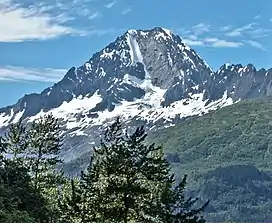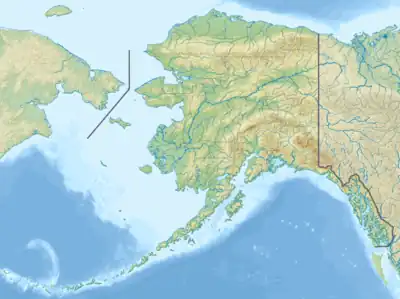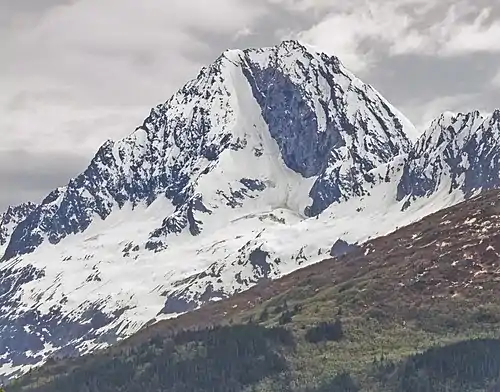| Meteorite Mountain | |
|---|---|
 Meteorite Mountain, north aspect | |
| Highest point | |
| Elevation | 6,565 ft (2,001 m)[1] |
| Prominence | 2,965 ft (904 m)[1] |
| Parent peak | Mount Benet |
| Isolation | 8.9 mi (14.3 km)[2] |
| Coordinates | 60°58′47″N 145°58′00″W / 60.97972°N 145.96667°W[3] |
| Geography | |
 Meteorite Mountain Location of Meteorite Mountain in Alaska | |
| Location | Valdez-Cordova Borough Alaska, United States |
| Parent range | Chugach Mountains |
| Topo map | USGS Cordova D-6 |
Meteorite Mountain is a prominent 6,565-foot (2,001 m) glaciated mountain summit located in the Chugach Mountains, in the U.S. state of Alaska. It is situated 16 mi (26 km) southeast of Valdez, 9 mi (14 km) south of Hogback Ridge, and 9 mi (14 km) southeast of Mount Francis. In January 1927, a meteorite hit this mountain, which is how the mountain got its name.[4] The mountain's name was in local use when it was first published in 1953 by U.S. Geological Survey.[3] Precipitation runoff and meltwater from the mountain's glaciers drains into tributaries of the Lowe River, which in turn empties to Prince William Sound.
Climate
Based on the Köppen climate classification, Meteorite Mountain is located in a subarctic climate zone with long, cold, snowy winters, and cool summers.[5] Weather systems coming off the Gulf of Alaska are forced upwards by the Chugach Mountains (orographic lift), causing heavy precipitation in the form of rainfall and snowfall. Temperatures can drop below −20 °C with wind chill factors below −30 °C. The months May through June offer the most favorable weather for viewing and climbing.
See also
References
- 1 2 "Meteorite Mountain, Alaska". Peakbagger.com. Retrieved 2020-03-07.
- ↑ Meteorite Mountain AK listsofjohn.com
- 1 2 "Meteorite Mountain". Geographic Names Information System. United States Geological Survey, United States Department of the Interior. Retrieved 2020-03-07.
- ↑ The Valdez Miner, July 9, 1927
- ↑ Peel, M. C.; Finlayson, B. L.; McMahon, T. A. (2007). "Updated world map of the Köppen−Geiger climate classification". Hydrol. Earth Syst. Sci. 11. ISSN 1027-5606.
Gallery

External links
- Weather forecast: Mountain-Forecast.com
- The meteor story, valdezalaska.org